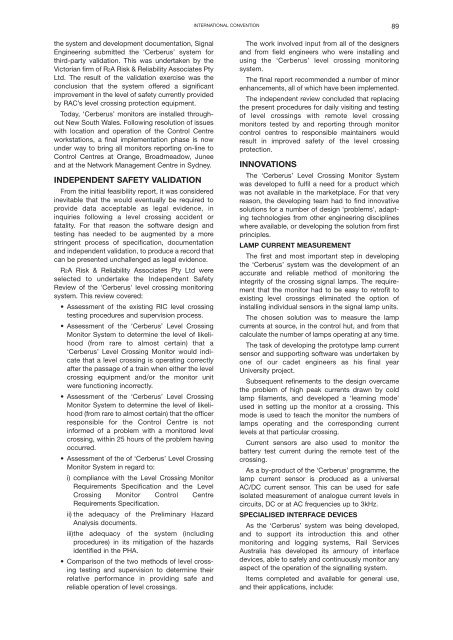Proceedings 2002/2003 - IRSE
Proceedings 2002/2003 - IRSE
Proceedings 2002/2003 - IRSE
You also want an ePaper? Increase the reach of your titles
YUMPU automatically turns print PDFs into web optimized ePapers that Google loves.
INTERNATIONAL CONVENTION 89<br />
the system and development documentation, Signal<br />
Engineering submitted the ‘Cerberus’ system for<br />
third-party validation. This was undertaken by the<br />
Victorian firm of R2A Risk & Reliability Associates Pty<br />
Ltd. The result of the validation exercise was the<br />
conclusion that the system offered a significant<br />
improvement in the level of safety currently provided<br />
by RAC’s level crossing protection equipment.<br />
Today, ‘Cerberus’ monitors are installed throughout<br />
New South Wales. Following resolution of issues<br />
with location and operation of the Control Centre<br />
workstations, a final implementation phase is now<br />
under way to bring all monitors reporting on-line to<br />
Control Centres at Orange, Broadmeadow, Junee<br />
and at the Network Management Centre in Sydney.<br />
INDEPENDENT SAFETY VALIDATION<br />
From the initial feasibility report, it was considered<br />
inevitable that the would eventually be required to<br />
provide data acceptable as legal evidence, in<br />
inquiries following a level crossing accident or<br />
fatality. For that reason the software design and<br />
testing has needed to be augmented by a more<br />
stringent process of specification, documentation<br />
and independent validation, to produce a record that<br />
can be presented unchallenged as legal evidence.<br />
R2A Risk & Reliability Associates Pty Ltd were<br />
selected to undertake the Independent Safety<br />
Review of the 'Cerberus' level crossing monitoring<br />
system. This review covered:<br />
• Assessment of the existing RIC level crossing<br />
testing procedures and supervision process.<br />
• Assessment of the ‘Cerberus’ Level Crossing<br />
Monitor System to determine the level of likelihood<br />
(from rare to almost certain) that a<br />
‘Cerberus’ Level Crossing Monitor would indicate<br />
that a level crossing is operating correctly<br />
after the passage of a train when either the level<br />
crossing equipment and/or the monitor unit<br />
were functioning incorrectly.<br />
• Assessment of the ‘Cerberus’ Level Crossing<br />
Monitor System to determine the level of likelihood<br />
(from rare to almost certain) that the officer<br />
responsible for the Control Centre is not<br />
informed of a problem with a monitored level<br />
crossing, within 25 hours of the problem having<br />
occurred.<br />
• Assessment of the of ‘Cerberus’ Level Crossing<br />
Monitor System in regard to:<br />
i) compliance with the Level Crossing Monitor<br />
Requirements Specification and the Level<br />
Crossing Monitor Control Centre<br />
Requirements Specification.<br />
ii) the adequacy of the Preliminary Hazard<br />
Analysis documents.<br />
iii)the adequacy of the system (including<br />
procedures) in its mitigation of the hazards<br />
identified in the PHA.<br />
• Comparison of the two methods of level crossing<br />
testing and supervision to determine their<br />
relative performance in providing safe and<br />
reliable operation of level crossings.<br />
The work involved input from all of the designers<br />
and from field engineers who were installing and<br />
using the ‘Cerberus’ level crossing monitoring<br />
system.<br />
The final report recommended a number of minor<br />
enhancements, all of which have been implemented.<br />
The independent review concluded that replacing<br />
the present procedures for daily visiting and testing<br />
of level crossings with remote level crossing<br />
monitors tested by and reporting through monitor<br />
control centres to responsible maintainers would<br />
result in improved safety of the level crossing<br />
protection.<br />
INNOVATIONS<br />
The ‘Cerberus’ Level Crossing Monitor System<br />
was developed to fulfil a need for a product which<br />
was not available in the marketplace. For that very<br />
reason, the developing team had to find innovative<br />
solutions for a number of design ‘problems’, adapting<br />
technologies from other engineering disciplines<br />
where available, or developing the solution from first<br />
principles.<br />
LAMP CURRENT MEASUREMENT<br />
The first and most important step in developing<br />
the ‘Cerberus’ system was the development of an<br />
accurate and reliable method of monitoring the<br />
integrity of the crossing signal lamps. The requirement<br />
that the monitor had to be easy to retrofit to<br />
existing level crossings eliminated the option of<br />
installing individual sensors in the signal lamp units.<br />
The chosen solution was to measure the lamp<br />
currents at source, in the control hut, and from that<br />
calculate the number of lamps operating at any time.<br />
The task of developing the prototype lamp current<br />
sensor and supporting software was undertaken by<br />
one of our cadet engineers as his final year<br />
University project.<br />
Subsequent refinements to the design overcame<br />
the problem of high peak currents drawn by cold<br />
lamp filaments, and developed a ‘learning mode’<br />
used in setting up the monitor at a crossing. This<br />
mode is used to teach the monitor the numbers of<br />
lamps operating and the corresponding current<br />
levels at that particular crossing.<br />
Current sensors are also used to monitor the<br />
battery test current during the remote test of the<br />
crossing.<br />
As a by-product of the ‘Cerberus’ programme, the<br />
lamp current sensor is produced as a universal<br />
AC/DC current sensor. This can be used for safe<br />
isolated measurement of analogue current levels in<br />
circuits, DC or at AC frequencies up to 3kHz.<br />
SPECIALISED INTERFACE DEVICES<br />
As the ‘Cerberus’ system was being developed,<br />
and to support its introduction this and other<br />
monitoring and logging systems, Rail Services<br />
Australia has developed its armoury of interface<br />
devices, able to safely and continuously monitor any<br />
aspect of the operation of the signalling system.<br />
Items completed and available for general use,<br />
and their applications, include:

















